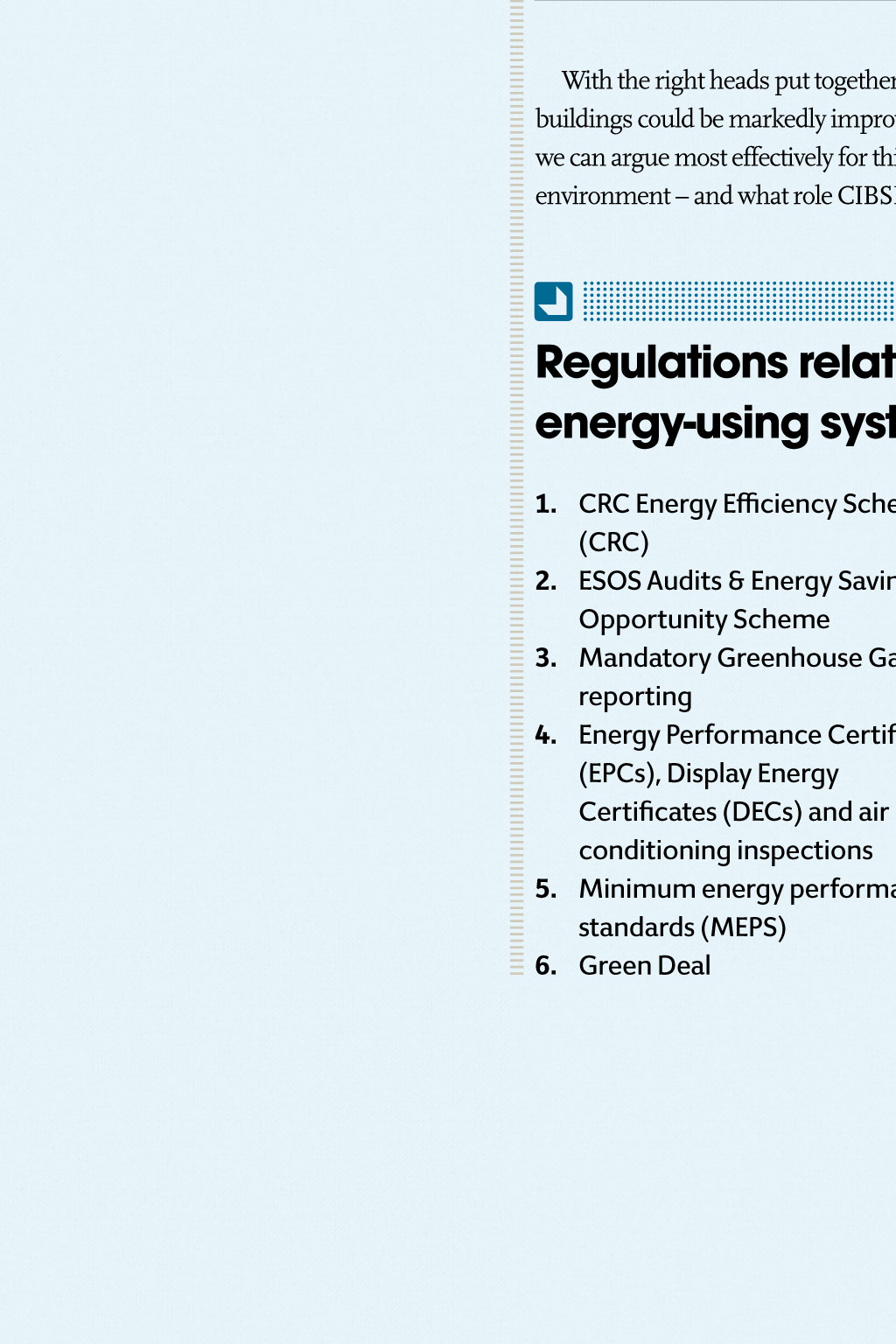












Opinion: Regulations Tackling The Energy Policy Trilemma A Whole host of policies affect energy use in the built environment. As a new administration looms, Hywel Davies reviews the current situation and considers the scope for improvement Hywel Davies, technical director of CIBSE www.cibse.org This is not efficient regulation; it penalises the compliant, undermines all the schemes, and may not save any energy Energy policy is built around three objectives: security of supply, reducing costs to consumers, and cutting emissions. This is the so-called energy trilemma because the three objectives are not necessarily compatible. Cutting emissions and bolstering security means lower carbon renewable generation, or nuclear power neither of which do much to reduce energy costs. Cutting costs tends to drive the use of the lowest marginal cost energy, which may not be low carbon, and may be imported. These objectives are not just a UK or even European concern; they occur around the world. The US majors on cost and security, but there is a growing realisation in Australia that environmental issues need to be taken more seriously as its agricultural industry faces serious challenges to cope with climate change. The recent destruction in Vanuatu wrought by one of the most powerful hurricanes in history has sparked a renewed debate about man-made changes in our environment. China and India, often used as excuses for inaction, are also agreeing that more must be done. With the UN conference on climate change later this year, there is a renewed impetus for governments to think about the environment. In the UK, a plethora of regulations and schemes affect energy use in buildings. The panel (below) shows just how much legislation there is in the area of buildings and energy. It also shows some of the overlaps between schemes, and the inconsistencies of approach. For example, the CRC scheme requires a fairly detailed annual emissions return for many large organisations public and private using the CRC reporting methodology. However, ESOS requires private companies that are also in CRC to apply a different methodology, doubling up on compliance costs. Whats more, a number of these organisations also come under the Greenhouse Gas (GHG) reporting methodology. This is not efficient regulation; it penalises the compliant, undermining all the schemes and it may not save any energy use or carbon emissions. Then there are energy certificates. From 2018, if you want to let a UK commercial building you will need to show that it is E-rated or better or bring it up to that standard under the new Minimum Energy Performance Standards for commercial property. In theory, you will be able to fund any improvements through the Green Deal, but as we know that is floundering. It may also be possible to do it through appropriate use of enhanced capital allowances (ECAs), but this requires upfront funding and there is a risk that the ECAs will not be allowed by HM Revenue and Customs. Quickly, the interdependencies become clear, along with the need for a more coordinated set of policies and measurement tools to meet them. However, what we have now is the exact opposite. We understand that, at present, compliance with Energy Performance Certificates (EPCs) on buildings that are sold or rented out may be no better than 39%. This means a number of buildings will escape minimum energy performance standards (MEPS) altogether, as MEPS only apply if you have an EPC. This cannot be rational, nor will it contribute to the policy intent behind MEPS to get older existing buildings refurbished. The lack of attention to one aspect of the policy mix undermines another. Perhaps a more rational world would bring ESOS, CRC and GHG reporting much closer. It could involve common metrics, allowing key performance characteristics to be measured once, and then for data to be reused again and again. It would reduce the range of measurements required, narrow the skills needed for delivery, and cut costs for businesses complying with all the current rules. It would also reduce the justification for those that fail to follow the rules. It might even mean looking to use some of the revenue from CRC to incentivise improvements by rewarding those with good energy efficiency programmes. This would fit well with the latest report from the House of Lords Select Committee, which clearly states that energy efficiency must be far higher up the political agenda if we are to achieve some of these multiple-policy targets. With the right heads put together in a quiet corner, the policy landscape for energy in buildings could be markedly improved. Come mid-May, we will have a better idea of how we can argue most effectively for this global approach to a more energy efficient built environment and what role CIBSE members can play in achieving it. regulations relating to energy use or energy-using systems in buildings 1. CRC Energy Efficiency Scheme (CRC) 2. ESOS Audits & Energy Savings Opportunity Scheme 3. Mandatory Greenhouse Gas reporting 4. Energy Performance Certificates (EPCs), Display Energy Certificates (DECs) and air conditioning inspections 5. Minimum energy performance standards (MEPS) 6. Green Deal 7. Enhanced Capital Allowances (ECAs) 8. Building Regulations, including Zero Carbon Homes and Code 9. Climate Change Agreements and Climate Change Levy 10. F-Gas Regulation & related requirements 11. Smart meters 12. EU minimum product-efficiency standards and energyperformance labelling